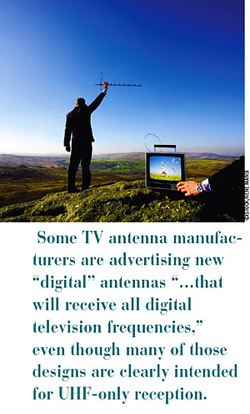The Three-Cup Shuffle
It's barely three months until NTSC broadcast television goes bye-bye forever. We're being bombarded with print ads, Internet postings, and TV spots telling that "the end is near!" and that we should repent—uh, that is, go out and pick up a new digital TV, or get with the NTIA converter box program. Even so, many people still aren't ready to give up their analog TV habits.
Anecdotal evidence from my church and from friends and neighbors shows that the DTV transition is only starting to enter their consciousness. Some of these folks don't subscribe to cable or satellite TV services and are still relying on indoor and outdoor antennas for reception. Others don't even own or use computers. It gets better.
The Nielsen Company released the results of a survey that show one out of every 12 U.S. households remains unprepared for Feb. 17, 2009, lacking either a digital TV or a compatible set-top box for receiving the ATSC broadcasts. Nielsen estimated about 10 million homes would be completely in the dark, while another 12.6 million have at least one analog TV that still isn't equipped with a converter box.
Homes with household incomes under $25,000 are five times more likely to be unable to receive digital broadcasts than homes with incomes more than $75,000, the research firm reported. The most prepared TV market? Ft. Myers/Naples Fla., with just 2.4 percent of homes behind the eight ball. The least prepared? Houston, with 16 percent of its TV households still anchored in the 20th century.
FAILURE TO PERCEIVE
It's evident that what we have here (with apologies to the movie Cool Hand Luke) is "failure to communicate." Or maybe "failure to pay attention." (Or both!)
Hard to believe, with all of the public service campaigns trumpeting the switchover. (Even my local post office has posters featuring the analog TV shutdown!)
But there's another fly in the ointment, and this one has even caught more than a few DTV early adopters off-guard. It originated in the FCC's Final DTV Channel Election tables, the most recent of which was published back on March 6, 2008 as Excel file FCC-08-72A2.

Unbeknownst to many viewers, there's going to be a game of musical chairs on or just before February 17 in numerous TV markets, big and small. Stations that are now on UHF channels will pack up and relocate to lowband or high-band VHF channels, some of which are already occupied by the station's analog transmissions. Others must relocate out of Channels 52 through 69 and back into the smaller DTV core Channels 2-51.
In some markets, the station moving must wait for the current ATSC occupant to pull up stakes and go back to its original analog channel, something that's not going to happen in most instances until February 17. I know of at least one ATSC station that can't even come on the air until D-Day, because its VHF DTV channel assignment (13) is still occupied by a long-time analog NBC affiliate that is currently sending out digital bits on VHF 12 and will move there permanently. Where will everyone wind up?
According to the FCC tables, 1,320 stations will remain camped in the UHF band; 452 stations will set up shop permanently on high-band VHF channels 7-13 (some are already there), with the majority of moves involving shutting down a station's legacy analog broadcast facility and lighting up its 8-VSB replacement.
Last but not least, there are 40 stations that (despite common RF engineering sense) are staying put on, or returning to VHF low-band Channels 2-6. This is the least desirable part of the TV spectrum, as those channels are very susceptible to natural and manmade impulse noise, not to mention interference from distant signals that "skip" across the country during the summer months.
RETUNING IN
Just how big a problem is this game of musical chairs? If a given viewer already has a VHF/UHF antenna in place, it's no big deal. They just need to remember to rescan for channels after the big day dawns, just like setting their clocks back or ahead twice a year. But those viewers are likely a small group.
Here's why: Unfortunately, there's a lot of urban legend-type advice offered to DTV neophytes that says, "all DTV stations operate on UHF TV channels."
To make matters worse, some TV antenna manufacturers are advertising new "digital" antennas "…that will receive all digital television frequencies," even though many of those designs are clearly intended for UHF-only reception. The result?
Many DTV viewers aren't aware that one or more of their favorite DTV stations could disappear altogether unless those viewers update their antenna systems pronto! In many parts of the country, it's already getting cold and windy outside, meaning the window for antenna work is closing fast. As you can see, things are going to get REAL interesting in about four months. Cue the piano player…
Peter Putman, KT2B, is president of ROAM Consulting in Doylestown, Pa., and maintains www.HDTVexpert.com. He also recently won InfoCOMM's Educator of the Year Award.
Get the TV Tech Newsletter
The professional video industry's #1 source for news, trends and product and tech information. Sign up below.
